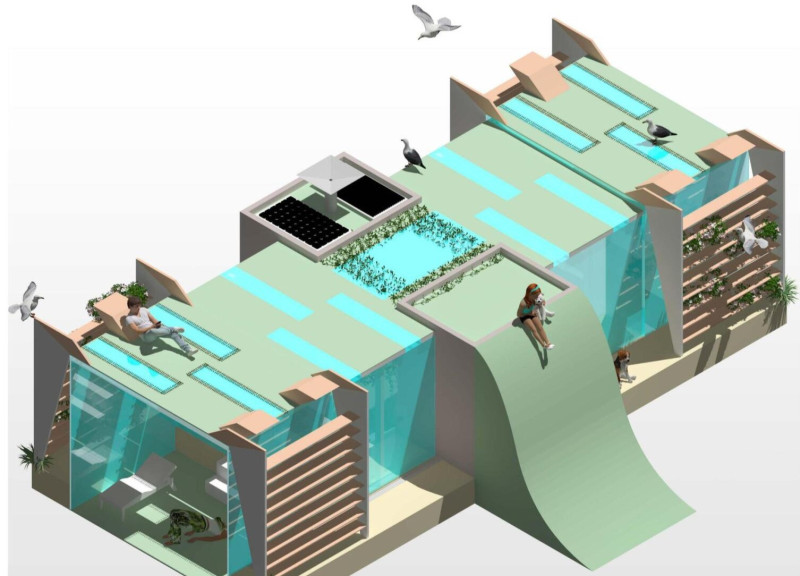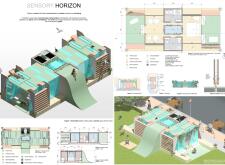5 key facts about this project
The project consists of interconnected building volumes that facilitate both private and communal living spaces. An important feature is the Kinetic Roof, which not only serves a functional purpose but also enhances the aesthetic appeal of the structure. This roof allows for outdoor activities and engages occupants with their surroundings, promoting a lifestyle connected to nature.
Sustainability is a core principle embedded in the design. The project utilizes renewable energy solutions, including solar panels and thermal collectors, which significantly reduce its carbon footprint. The incorporation of green roofs and a variety of plant species contributes to stormwater management and enhances biodiversity within the urban setting.
The design also prioritizes natural light and ventilation through extensive use of glazing and skylights. This design approach integrates interior spaces seamlessly with the external environment, creating a brighter atmosphere and enhancing user comfort. The strategic placement of communal areas encourages social interaction and community building among residents.
Unique Features of the Design
The project’s innovative Kinetic Roof distinguishes it from typical residential and communal structures. This feature not only provides shade and shelter but also encourages social activities, allowing for flexibility in how residents use the space. The roof can serve as an outdoor living area, blurring the lines between inside and outside, which is essential in densely populated urban settings where green space is limited.
Additionally, the architecture incorporates a sophisticated water and wind collector system that illustrates a serious commitment to sustainable resource management. By utilizing these elements, the project aims for self-sufficiency in water and energy, aligning with modern architectural strategies addressing climate change and resource scarcity.
Sustainable Material Usage
The choice of materials in the project reflects a focus on sustainability and resilience. Timber flooring conveys warmth and comfort while also emphasizing ecological responsibility. Stone cladding provides durability and blends with the natural environment. The extensive use of green roofing and vegetation not only contributes to the aesthetic design but also plays a vital role in improving air quality and managing rainwater.
Integrating these materials reinforces the project’s goal of enhancing human connection to nature while ensuring structural resilience. The emphasis on natural materials promotes not just sustainability but also a deep-rooted relationship with the surrounding ecosystem, further solidifying its architectural purpose.
For a more in-depth exploration of the design elements, including architectural plans, sections, and ideas, interested readers are encouraged to view the comprehensive project presentation. Understanding the nuances of the design will provide greater insight into how "Sensory Horizon" defines modern architectural practices while addressing both ecological and social aspects of urban living.























